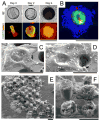In vitro generation of colonic epithelium from primary cells guided by microstructures
- PMID: 24647645
- PMCID: PMC4037563
- DOI: 10.1039/c3lc51353j
In vitro generation of colonic epithelium from primary cells guided by microstructures
Abstract
The proliferative compartment of the colonic epithelium in vivo is located in the basal crypt where colonic stem cells and transit-amplifying cells reside and fuel the rapid renewal of non-proliferative epithelial cells as they migrate toward the gut lumen. To mimic this tissue polarity, microstructures composed of polydimethylsiloxane (PDMS) microwells and Matrigel micropockets were used to guide a combined 2-dimensional (2D) and 3-dimensional (3D) hybrid culture of primary crypts isolated from the murine colon. The 2D and 3D culture of crypts on a planar PDMS surface was first investigated in terms of cell proliferation and stem cell activity. 3D culture of crypts with overlaid Matrigel generated enclosed, but highly proliferative spheroids (termed colonoids). 2D culture of crypts produced a spreading monolayer of cells, which were non-proliferative. A combined 2D/3D hybrid culture was generated in a PDMS microwell platform on which crypts were loaded by centrifugation into microwells (diameter = 150 μm, depth = 150 μm) followed by addition of Matrigel that formed micropockets locking the crypts within the microwells. Embedded crypts first underwent 3D expansion inside the wells. After the cells filled the microwells, they migrated onto the surrounding surface forming a 2D monolayer in the array regions without Matrigel. This unique 2D/3D hybrid culture generated a continuous, millimeter-scale colonic epithelial tissue in vitro, which resembled the polarized architecture (i.e. distinct proliferative and non-proliferative zones) and geometry of the colonic epithelium in vivo. This work initiates the construction of a "colon-on-a-chip" using primary cells/tissues with the ultimate goal of producing the physiologic structure and organ-level function of the colon.
Figures




Similar articles
-
Capture and 3D culture of colonic crypts and colonoids in a microarray platform.Lab Chip. 2013 Dec 7;13(23):4625-34. doi: 10.1039/c3lc50813g. Lab Chip. 2013. PMID: 24113577 Free PMC article.
-
Human colonic crypts in culture: segregation of immunochemical markers in normal versus adenoma-derived.Lab Invest. 2014 Feb;94(2):222-34. doi: 10.1038/labinvest.2013.145. Epub 2013 Dec 23. Lab Invest. 2014. PMID: 24365748 Free PMC article.
-
Cryosectioning Method for Microdissection of Murine Colonic Mucosa.J Vis Exp. 2015 Jul 12;(101):e53112. doi: 10.3791/53112. J Vis Exp. 2015. PMID: 26274554 Free PMC article.
-
The gastrointestinal tract stem cell niche.Stem Cell Rev. 2006;2(3):203-12. doi: 10.1007/s12015-006-0048-1. Stem Cell Rev. 2006. PMID: 17625256 Review.
-
3D in vitro morphogenesis of human intestinal epithelium in a gut-on-a-chip or a hybrid chip with a cell culture insert.Nat Protoc. 2022 Mar;17(3):910-939. doi: 10.1038/s41596-021-00674-3. Epub 2022 Feb 2. Nat Protoc. 2022. PMID: 35110737 Free PMC article. Review.
Cited by
-
Microbiota-Host Immunity Communication in Neurodegenerative Disorders: Bioengineering Challenges for In Vitro Modeling.Adv Healthc Mater. 2021 Apr;10(7):e2002043. doi: 10.1002/adhm.202002043. Epub 2021 Mar 4. Adv Healthc Mater. 2021. PMID: 33661580 Free PMC article. Review.
-
Self-renewing Monolayer of Primary Colonic or Rectal Epithelial Cells.Cell Mol Gastroenterol Hepatol. 2017 Mar 6;4(1):165-182.e7. doi: 10.1016/j.jcmgh.2017.02.011. eCollection 2017 Jul. Cell Mol Gastroenterol Hepatol. 2017. PMID: 29204504 Free PMC article.
-
The pleiotropic effects of prebiotic galacto-oligosaccharides on the aging gut.Microbiome. 2021 Jan 28;9(1):31. doi: 10.1186/s40168-020-00980-0. Microbiome. 2021. PMID: 33509277 Free PMC article.
-
Extracellular Microenvironmental Control for Organoid Assembly.Tissue Eng Part B Rev. 2022 Dec;28(6):1209-1222. doi: 10.1089/ten.TEB.2021.0186. Epub 2022 Jun 21. Tissue Eng Part B Rev. 2022. PMID: 35451330 Free PMC article. Review.
-
Quantitative Systems Pharmacology Approaches Applied to Microphysiological Systems (MPS): Data Interpretation and Multi-MPS Integration.CPT Pharmacometrics Syst Pharmacol. 2015 Oct;4(10):585-94. doi: 10.1002/psp4.12010. Epub 2015 Oct 5. CPT Pharmacometrics Syst Pharmacol. 2015. PMID: 26535159 Free PMC article.
References
-
- Yen TH, Wright NA. Stem Cell Rev. 2006;2:203–212. - PubMed
Publication types
MeSH terms
Substances
Grants and funding
LinkOut - more resources
Full Text Sources
Other Literature Sources

